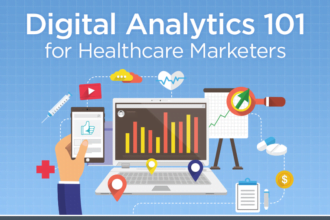It’s the end of the year, so you know what that means. All the armchair prognosticators come out of the woodwork to make their futuristic claims. But let’s get real here. Most of these “trends to watch” stories really should be titled
It’s the end of the year, so you know what that means. All the armchair prognosticators come out of the woodwork to make their futuristic claims. But let’s get real here. Most of these “trends to watch” stories really should be titled
“the 10 things early adopter companies with unlimited budgets will be experimenting with next year.” Much as we’d like to, most of us don’t live in this world. So what’s a tech realist to do? We’ve outlined 10 tech trends that are going mainstream…and what your healthcare business should be doing about it in the coming year.
1) The inevitability of mobile access
Up to now, many marketers have been treating mobile marketing as window dressing–a fun little experiment to add on to their project list. But the rise of smartphones has made reaching out to your audience in the mobile space a necessity. This chart from Neilsen shows that smartphones will dominate the cell phone market as soon as early next year. Which means that your customers will be looking up your products, your prices, your web address, your phone number…all through their phone. It’s time to make sure your website is mobile ready, and your customers have all the information they need to know about you, on the go. Don’t neglect the low-hanging fruit. Is your Facebook, LinkedIN and Google Business Place Page claimed? Can people easily email you or pho ne you by pushing a link? If your customers access your ecommerce site on your smartphone, can your customers read, search, purchase and share their purhcases with ease? Is your standard website easy to read on a phone, and enabled for a tablet? Ignore these questions at your peril.
ne you by pushing a link? If your customers access your ecommerce site on your smartphone, can your customers read, search, purchase and share their purhcases with ease? Is your standard website easy to read on a phone, and enabled for a tablet? Ignore these questions at your peril.
2) The Rise of the App
With the emergence of smartphones, comes the rise of the App. App development has exploded at crazy, triple digit growth rates in nearly every subject category, including healthcare. We’re very excited about the possibilities here at Vest, and have even created a partnership with Elementz Interactive to help us create them for clients. But should your company have one? There is a lot of debate, after all, about whether to have a mobile website or a mobile app. And it’s easy for apps to go unpromoted and unused…lost in the app store echo chamber. Ask yourself this question: what information does my customer need to know on the go? Do they need account access? E-commerce functionality? Coupons or special offers? Curated information? If you need to link any of these functions to a significant back-end database, or lead your viewer through a lot of steps, an app will do the job better. You just need to have a solid plan for promoting it on site, on the web and through traditional and social channels to make it work best for you.
3. Internet Video Takes Over
Honestly, we could go on all day about the stats in the rise of Internet video. It is already one of the most effective tools in the tool box. Consider this: 82.5% of the US Internet audience viewed a video online (Comscore). A 2010 report from Cisco predicted 30 percent of all Internet traffic is for video…and will jump to 66% in 2014. Internet Retailer magazine reported in 2010 that online viewers who viewed a video were 85% more likely to buy a product. Emails with videos have two to three times the open rates as those without. Shall I continue? As more people get 4G smartphones, fast tablets and Internet-connected, flat-screen TVs, people are going to be looking for more personal, informative content on-demand from companies, and video is the perfect avenue. And they don’t have to be slick. If you’re a physician, how about doing short videos answering the questions you hear over and over from patients, and posting that on a Facebook page and webpage? The options are endless. Just don’t do a video for the sake of doing it. Make sure it’s information that’s worth your target’s time, and it’s short–5 minutes or less, ideally.
4) From social applications to social organizations
2012 will be the year that we see more and more healthcare organizations transition from merely having a page on Facebook, to integrating social media into their entire corporate function. That means tying in social media streams into the customer service function, so the the organization can respond to complaints made randomly on the Internet in a direct way. Or, instead of having one blogger, organizations will have bloggers/social media experts throughout, telling the company’s story, using blog management products like Compendium. Company Intranets will go fully social and be pulled more easily into employee’s existing social networks. You’ll even start to see brick-and-mortar chains with a different social media presence for each store, using tools like Expion. Companies will start offering more customer forums (like Mayo Clinic) that allow people with similar concerns to talk to each other, not just to them. The tools for managing this kind of efforts are out there, more scalable, affordable and measurable than ever before. For more information on this communication philosophy, try one of my favorite social media books, The Now Revolution by Amber Naslund and Jay Baer.
5) Location Based Marketing and the Point of Discovery
Much ado has been made about Foursquare and QR codes this year. Scoffers have noted with much satisfaction that only around 10 percent of the smartphone audience is using services like Foursquare and Google Places to “check in” when they go places. The people who do use Foursquare, though, are a loyal bunch and their numbers are growing. This is amazing, really, because so few companies are using this largely free technology to to offer coupons, ask customers for survey results, get tips and recommendations, bring in people searching the area for deals and create lasting loyalty with customers. If this many people are involved with not a whole lot of incentive yet, imagine how it will be when companies start making it worth their while. Smartphones will only grow this segment, and it’s not going away anytime soon.
QR codes are another case in point. People are now starting to know what they are and what to do with them, though we still have a ways to go to get to the kind of adoption rates you see in Asia and Europe. Thing is, most companies have done a woefully inadequate job of using them properly. (ie. the insipid celebrity videos, the poorly working contest entry fields, the bad links…) Again, ask yourself, what information does my customer want on the go? Can they enter a lucrative contest…but always get a coupon if they don’t win? Can I show them how this product can be used with others in the store? Can I give them directions, answer common questions, or provide meaningful product details? Tools like 44Doors, a white-label partner of ours, offer the ability to manage multiple mobile websites off your QR codes, for not a lot of money. This year, think how you can use QR codes for e-commerce, contests, giveaways, data collection and more. Your customers will reward you for it.
6) Do-It-Yourself Journalism
PR has changed. First, we were all concerned about getting our stories written up by journalists in the traditional press. Then, it was all about “blogger relations.” Now don’t get me wrong…those things haven’t gone away. But now, if you can write a meaningful, interesting blog or even a press release, you can
“publish” it directly to your target audience by posting it on aggregation and forum sites in your industry. For instance, this blog post will probably appear in Insider Louisville, Exploring Social Media and several other places before I’m done with it. And that’s not to mention the 25 or so odd LinkedIn groups I belong to, plus my status updates. Don’t forget…most traditional newspaper sites will now allow you to upload your press releases to their archives automatically. Then of course, there’s always the email newsletter, your Facebook page, your Google+…where your stories can go directly to your audience, too. The options for disseminating your message are nearly endless.
7) Making Sense of it all with Content Curation
The idea behind content curation is that industry information is becoming so pervasive and so overwhelming that consumers will turn to the companies/individuals/experts that can “curate” the information the best. So
instead of just putting out information about your products, you might also be “curating” a feed of news about your industry that would be relevant to your customers, making you a news source and trusted advisor to your customers. Industry pundits like Shel Holtz have done a great job of articulating the opportunity that comes with content curation. Tools like scoop.it or Storify are making it very easy–even automatic, to do. (To see what I’m talking about, check out the Vest Telemedicine Daily on paper.li from one of my colleagues, Dawn Wigginton, who sends this out every day to more than 700 Twitter followers @dawnwigg.)
8) SEO and Keyword Marketing Become Mandatory
As information continues to grow exponentially, the ability for your customers to be able to find your company through search becomes even more important. Knowing the keywords your target customer uses when they are searching for you, your products, or related products is crucial to your success. Your website needs to be optimized for those searches, preferably with online/social media advertising and blog p osts that tie directly back to those keywords in your website. It’s a lot cheaper and easier than it sounds. Take a look at one of our case studies for Dr. Shep, where we worked a marketing miracle with just a little online strategy and Google Advertising.
osts that tie directly back to those keywords in your website. It’s a lot cheaper and easier than it sounds. Take a look at one of our case studies for Dr. Shep, where we worked a marketing miracle with just a little online strategy and Google Advertising.
9) Personal Branding Becomes Standard
While issues of intellectual property, personal vs. corporate promotion and privacy continue to be debated, one thing cannot be denied. In the digital age, you have a personal brand, whether you like it or not. If you don’t believe me, just type your name into the Google search bar. 2012 will be the year that professionals, en masse, clean up their digital act…tidying up their LinkedIn profile, tightening their Facebook security settings, buying up their domain names, creating their own Google and Google +profiles, untagging photos, getting rid of insipid or embarrassing email addressees, and more. The day is coming, and soon, when it’s standard operating procedure to have your own, free-standing, professional website with your resume, portfolio, blog posts and feeds all in one place. Companies, as your employees start to do this, you need to be thinking about your social media policy, what kind of behavior you expect from your employees, and what they can and cannot say about their employer or industry in their personal accounts. For advice on the matter, check out socialmediagovernance.com. For training or more serious help on social policies, just email me.
10) Conversion, Measurement and ROI at the Heart of It All
Up to now, many people have viewed online or social media tactics as
unmeasurable PR gambits. After all, how can you really measure the value of a retweet, an online contact or a digital relationship? While there will always be a part of online marketing/pr that is impossible to pin down, you CAN get some meaningful numbers if you plan conversion points into your effort. How many people linked from your Facebook post, to your ecommerce site, to the free online coupon, to an online purchase, for instance? How large was the audience that saw and retweeted your message? How did that affect sales? Did your online newsletter generate interest and lift in your special event reservations? How many linkbacks did you get? How many people who are reading your curated newsletter are buying your products? What parts of your website are most interesting and most clicked? The fact is, digital tools give us more monitoring options and more control over our message, not less.
In 2012…how will your healthcare organization be using all that power?











